 Crigler–Najjar syndrome is a rare inherited disorder affecting the metabolism of bilirubin.
Crigler–Najjar syndrome is a rare inherited disorder affecting the metabolism of bilirubin.
The disorder results in a form of nonhemolytic jaundice, which results in high levels of unconjugated bilirubin and often leads to brain damage in infants.
The disorder is inherited in an autosomal recessive manner.
The annual incidence is estimated at 1 in 1,000,000.
This syndrome is divided into types I and II.
These two types, along with Gilbert’s syndrome, Dubin–Johnson syndrome, and Rotor syndrome, make up the five known hereditary defects in bilirubin metabolism.
Only a few causes of Crigler–Najjar syndrome have been recognized.
Signs and symptoms include: jaundice, diarrhea, vomiting, fever, confusion, slurred speech, difficulty swallowing, change in gait, staggering, frequent falling and seizures.
It is caused by abnormalities in the gene coding for uridine diphosphoglucuronate glucuronosyltransferase (UGT1A1).
UGT1A1 normally catalyzes the conjugation of bilirubin and glucuronic acid within hepatocytes.
Conjugated bilirubin is more water-soluble and is excreted in bile.
Type I Crigler-Najjar syndrome:
Estimated at 0.6–1.0 per million live births.
Inheritance is autosomal recessive.
Intense jaundice appears in the first days of life and persists thereafter.
Type 1 is characterised by a serum bilirubin usually above 20 mg/dL (reference range f0.1–0.8 mg/dL).
No UDP glucuronosyltransferase 1-A1 expression can be detected in the liver tissue.
Phenobarbital, which causes CYP450 enzyme induction has no response in C-NS.
Most patients have type IA disease with a mutation in one of the common exons, and have difficulties conjugating several additional substrates.
Patients type IB have mutations limited to the bilirubin-specific A1 exon, with a conjugation defect is mostly restricted to bilirubin itself.
Before phototherapy, these children died of bilirubin encephalopathy, or survived until early adulthood with clear neurological impairment.
Presently plasmapheresi in the immediate neonatal period,
12 hours/day phototherapy, heme oxygenase inhibitors to reduce transient worsening of hyperbilirubinemia, oral calcium phosphate and carbonate to form complexes with bilirubin in the gut
liver transplantation before the onset of brain damage and before phototherapy becomes ineffective at later age are available.
The inheritance patterns of both Crigler–Najjar syndrome types I and II are autosomal recessive.
Type II differs from type I:
Bilirubin levels are generally below 345 μmol/L [20 mg/dL] and some cases are only detected later in life.
Because of lower serum bilirubin, kernicterus is rare in type II.
Bile is pigmented, instead of pale in type I or dark as normal, and monoconjugates constitute the largest fraction of bile conjugates.
UGT1A1 is present at reduced but detectable levels, typically <10% of normal.
Therefore, treatment with phenobarbital is effective, generally with a decrease of at least 25% in serum bilirubin.
Differential diagnosis:
Neonatal jaundice may develop from sepsis, hypoxia, hypoglycemia, hypothyroidism, hypertrophic pyloric stenosis, galactosemia, and fructosemia.
Hyperbilirubinemia of the unconjugated type may be caused by:
increased production
hemolysis-hemolytic disease of the newborn, hereditary spherocytosis, sickle cell disease
ineffective erythropoiesis
massive tissue necrosis or large hematomas
decreased clearance
drug-induced
physiological neonatal jaundice and prematurity
liver diseases such as advanced hepatitis or cirrhosis
breast milk jaundice
In Crigler–Najjar syndrome and Gilbert syndrome, routine liver function tests are normal, and hepatic histology usually is normal, too.
Physiological neonatal jaundice may peak at 85–170 μmol/L and decline to normal adult concentrations within two weeks.
Prematurity results in higher levels.
Treatment
Plasmapheresis and phototherapy are used for treatment.
Liver transplant is curative.
Gene therapy studies are presently being undertaken.
